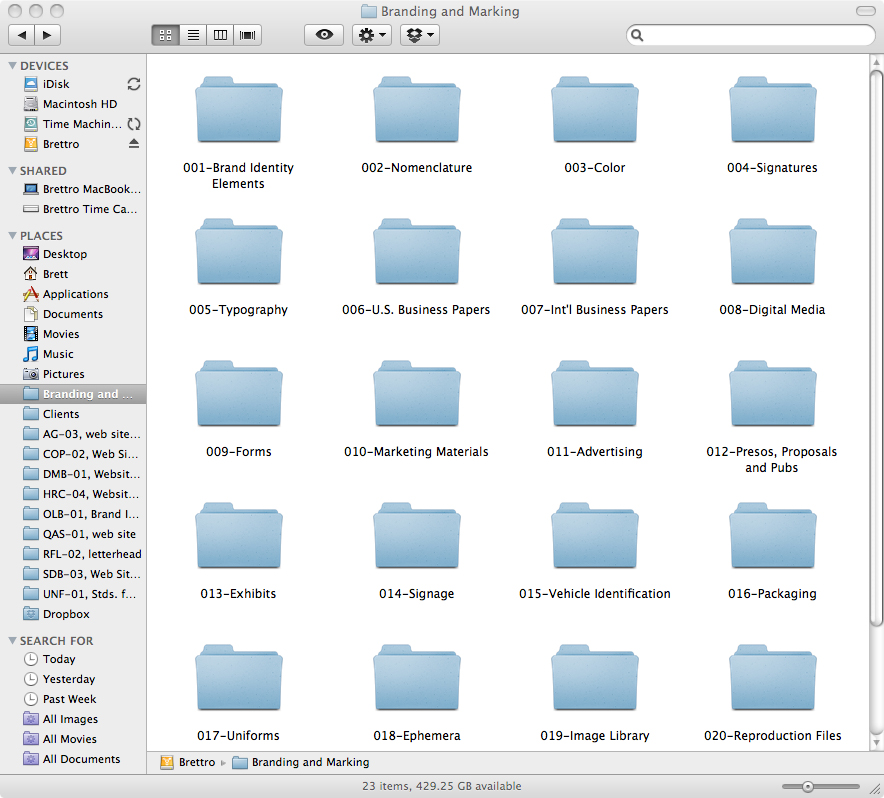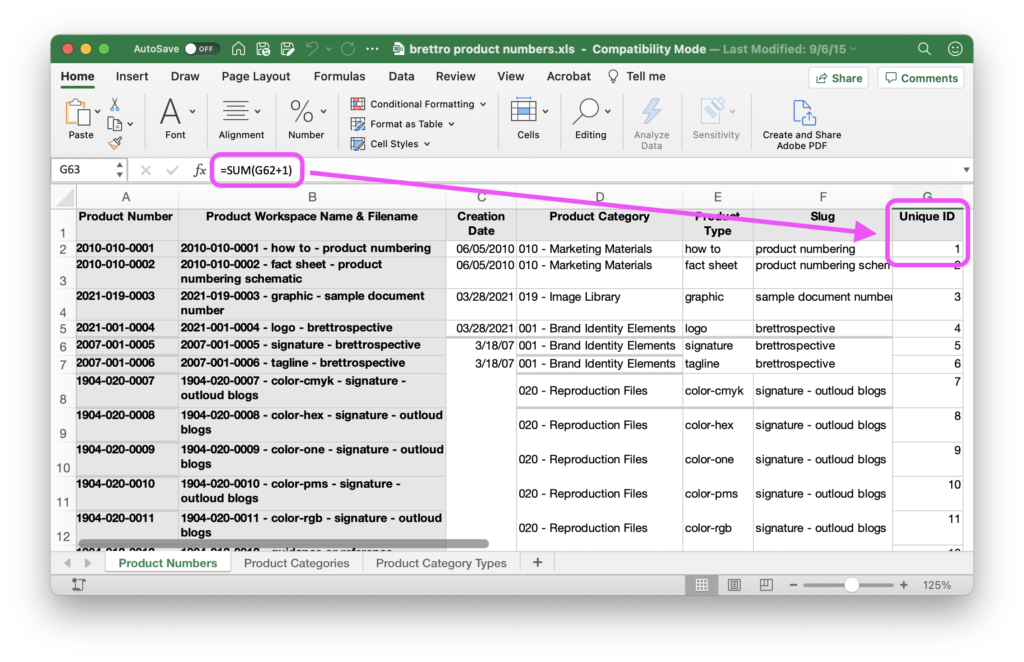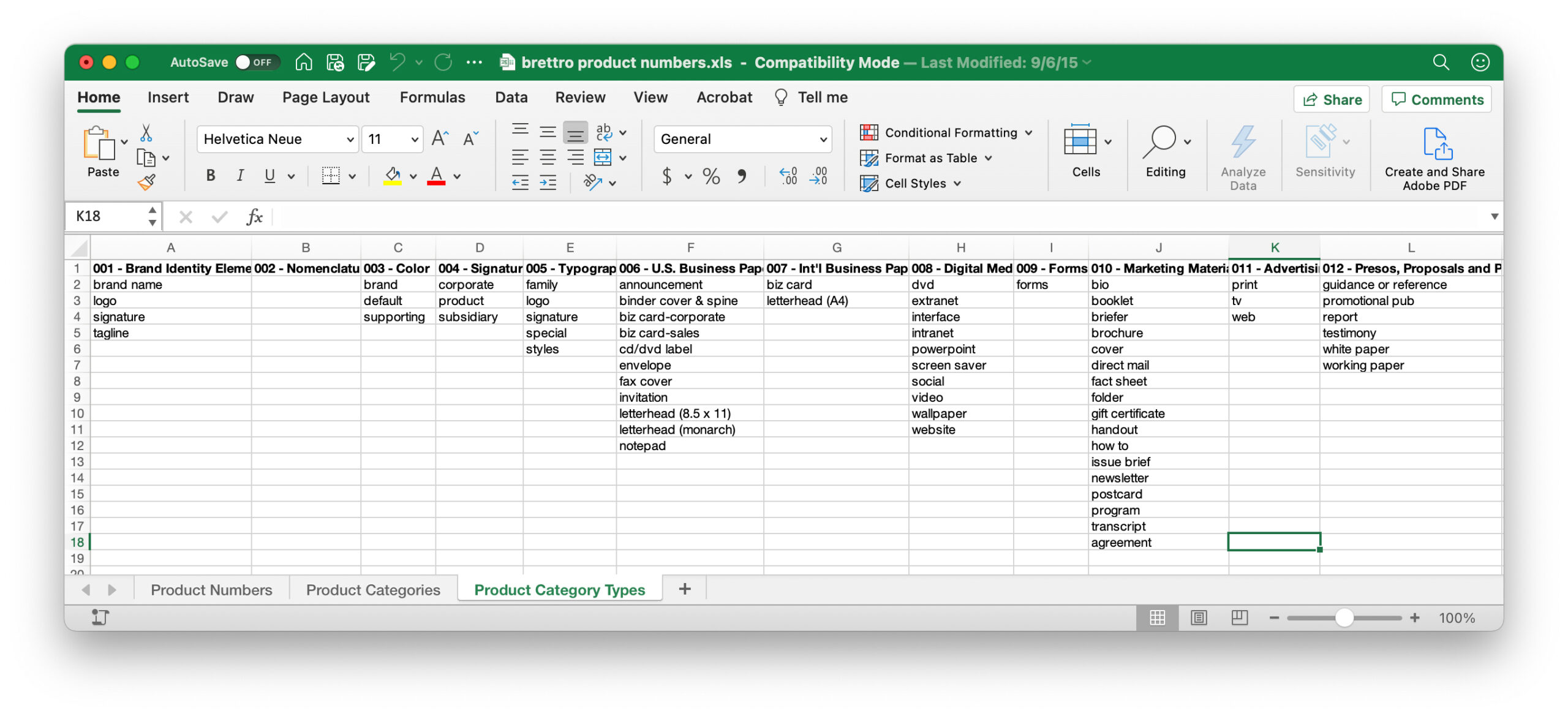
Brettro Product Numbering, File Naming and File Structure Standards
September 3, 2020
For years I wrestled with how to name my creative documents and where to consistently and logically save them.
Then, in 2006 I came across Designing Brand Identity by Alina Wheeler. The book is a comprehensive guide to brand development and maintenance and is an incredible resource for learning how to do it. I have purchased every new edition that has been published since 2006, with the most recent published in 2017.
The one page in the entire book I found the most useful, though, was the page containing a proposed outline for a branding manual. The suggested sections organized creative material in a comprehensive, logical and meaningful way and—for me—really seemed to lend itself to a solid, future proof file structure.
Establishing the File Structure

The file structure is divided into 20 folders that align with the primary product categories defined in Designing Brand Identity. They are:
- 001 – Brand Identity Elements
- 002 – Nomenclature
- 003 – Color
- 004 – Signatures
- 005 – Typography
- 006 – U.S. Business Papers
- 007 – International Business Papers
- 008 – Digital Media
- 009 – Forms
- 010 – Marketing Materials
- 011 – Advertising
- 012 – Presos, Proposals and Pubs
- 013 – Exhibits
- 014 – Signage
- 015 – Vehicle Identification
- 016 – Packaging
- 017 – Uniforms
- 018 – Ephemera
- 019 – Image Library
- 020 – Reproduction Files
Files are saved in their own folder within each of these folders using the file naming standard I developed.
Establishing the Product Numbering Standard
I use my product numbering standard for all my visually branded documents, videos and other creative materials. This standard creates a unique identifier for each product allowing it to be easily identified and located.
The number is a quartet combining four groupings to create a unique number:
- Calendar year: including the calendar year as part of the product number provides instant recognition for the year the product was created, context for discussions on how the product has aged and can serve as a guidepost for referencing invoices for material production;
- Product category: the product category is a reference to the file structure outlined above; this number makes it significantly easier to find a file in the file structure by narrowing the search to a single folder;
- Unique ID: this number is the only truly unique identifier for a product in the standard. This four-digit number can only be used once and is the thing used to identify a product in its product category folder. See “Creating the Unique ID” to learn how this number is created.
- Version number: this number indicates the version of the product.
Creating the Unique ID

Figuring out how to create a unique number and maintain a list of those numbers was the most challenging part of establishing this standard. I finally settled on an Excel file that creates a unique ID based on the row number in the spreadsheet.

This means, however, that you cannot delete a row once an entry has been created, otherwise it will ruin the whole unique ID scheme. That is a pretty big flaw, but since I am the only person who uses this system on Brettro material, it is functional.
Framework for Determining Version Numbering
Determining when and how to assign a new version number versus a new product number versus not assigning anything new can be difficult. That decision requires a framework to make the determination and that framework is based around the product’s lifecycle. Every product has a usable life: there is a defined beginning and a defined ending, but the tricky part is defining how a product changes between its beginning and ending
The decision framework has four basic questions:
- Is this a new product? A new product is an item that has not yet been created or the product’s design or content is completely changed. A new product requires an entirely new product number that resets the version back to one.
- Is this a revision or an edit? A revision is a modification to an existing product’s design or content that changes or clarifies the design’s or content’s original intent, message, or theme. An edit is a minor modification to an existing product’s design or content that does not change the design’s or the content’s intent, message, or theme. An edit typically corrects grammar, spelling, or style.
- Revision: requires a new version number.
- Edit: does not require a new version number.
- Is this a periodical or a serial? A periodical and a serial are products created and published multiple times annually with a similar topic or theme. These are special cases in versioning where each new issue results in the creation of a new version number, not a new product number. A new product number, however, is created at the beginning of every calendar year.
Examples of periodicals are catalogs and newsletters. And examples of serials are brochures, quarterly reports and semi-annual reports. - Is this a build? A build is a unique draft created in the design phase of a product. Many designers create multiple builds of a product as part of their creative process. Once a build is determined to be the final design, the other builds should be deleted or placed in a folder named “builds.” A build does not requires a new version number. When saving a build file add a lowercase letter after the version number to indicate a unique build. For example, in this filename, 2010-002-0001-02a.indd, the lowercase letter a indicates a unique build.
Developing the Folder and File Naming Standard
The folder and file naming standard is based on both the product categories established in the file structure section and product numbering standard section.
The folder naming convention is XXXX-XXX-XXXX – type – three word slug.

The file naming convention is XXXX-XXX-XXXX-XX – type – three word slug.

Product Type
The product type is a secondary categorization that more granularly describes the type of product being created. I developed the initial list of product types referencing Wheeler’s Designing Brand Identity, but over time have added others.
Product types should describe a product in general terms and should follow the “one-to-many” principle whereby the product type (the one) generally describes multiple types of products (the many) in one or two words. New product types can be added, but should be done so rarely.
The source list of product types is kept in the Excel file used for creating unique IDs.

Three Word Slug
The three word slug should describe the purpose and/or content of the product. I do my best to limit myself to three words, but sometimes I end up using four or five.
Product Tracker Spreadsheet
The spreadsheet I use to track and create unique IDs functions as more than just that. Its primary function is a product tracker to capture not only a product’s unique ID but also to capture its product category, product type and slug.
Thirteen Years and Counting
I have been consistently using this standard for 13 years both at Brettro and Uncle Sam, Inc. It has held up very well in both places with no significant changes in that time.
